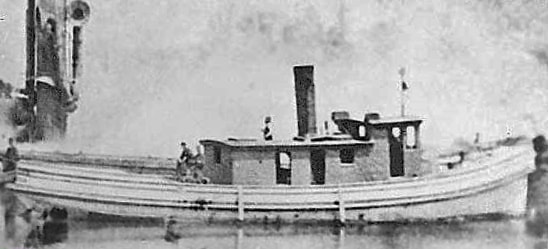Vulcan Fire Nearly Takes The Crew
By James Donahue
The crew of the tug Vulcan barely had time to escape the early morning fire that swept the boat in Lake Erie on June 7, 1883.
The powerful tug was off Cedar Point, Ohio, with a raft of logs in tow, when the fire broke out somewhere behind the smoke stack at about 2 a.m.
First Mate Alex Cattanach said he was standing aft of the stack, talking to the watchman, when he smelled smoke and suspected a fire. “Looking just aft of the smokestack I saw a little smoke and told the watchman to put on the hose,” he said.
At about the same time the engineer came on deck and announced that the boat was on fire. “I told him to put on the pony (a steam engine that operates the fire pump) which he did at once. Then (I) gave the alarm of the fire to rouse the crew,” Cattanach said.
Before Cattanach could get enough men mustered to fight the fire, the flames were breaking out throughout the wooden vessel. Capt. W. H. Rolls ordered the fire fighters to train the water hose on the lifeboat so the men would have a way of escape.
Wheelman John S. Paganetti said it was a narrow escape for the 14 members of the Vulcan’s crew. He said that by the time they got the lifeboat launched, its hull was scorched. The men tumbled into it even as the fire licked at their heels.
The engine room crew didn’t get the main engine shut down so the Vulcan continued running at full steam, with the log raft still in tow, which made the escape on the lifeboat even more dangerous.
Paganetti said the tow line connecting the blazing tug with the log raft finally burned through. After that, he said the Vulcan, free of its burden, galloped off at full speed into the night with nobody at the wheel. He said the fire “made a grand sight for miles around.”
Strangely enough, the tug did not sink. Its smoldering hull was towed into Vermillion, Ohio, later in the day. The wreck was never rebuilt.
By James Donahue
The crew of the tug Vulcan barely had time to escape the early morning fire that swept the boat in Lake Erie on June 7, 1883.
The powerful tug was off Cedar Point, Ohio, with a raft of logs in tow, when the fire broke out somewhere behind the smoke stack at about 2 a.m.
First Mate Alex Cattanach said he was standing aft of the stack, talking to the watchman, when he smelled smoke and suspected a fire. “Looking just aft of the smokestack I saw a little smoke and told the watchman to put on the hose,” he said.
At about the same time the engineer came on deck and announced that the boat was on fire. “I told him to put on the pony (a steam engine that operates the fire pump) which he did at once. Then (I) gave the alarm of the fire to rouse the crew,” Cattanach said.
Before Cattanach could get enough men mustered to fight the fire, the flames were breaking out throughout the wooden vessel. Capt. W. H. Rolls ordered the fire fighters to train the water hose on the lifeboat so the men would have a way of escape.
Wheelman John S. Paganetti said it was a narrow escape for the 14 members of the Vulcan’s crew. He said that by the time they got the lifeboat launched, its hull was scorched. The men tumbled into it even as the fire licked at their heels.
The engine room crew didn’t get the main engine shut down so the Vulcan continued running at full steam, with the log raft still in tow, which made the escape on the lifeboat even more dangerous.
Paganetti said the tow line connecting the blazing tug with the log raft finally burned through. After that, he said the Vulcan, free of its burden, galloped off at full speed into the night with nobody at the wheel. He said the fire “made a grand sight for miles around.”
Strangely enough, the tug did not sink. Its smoldering hull was towed into Vermillion, Ohio, later in the day. The wreck was never rebuilt.
